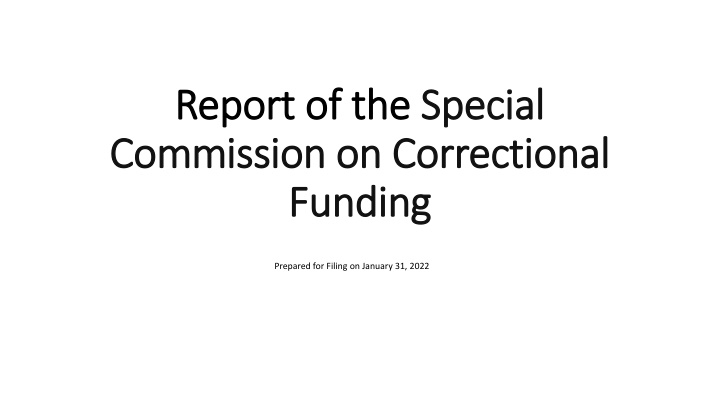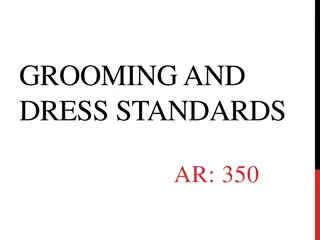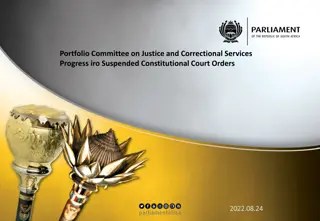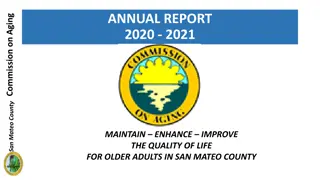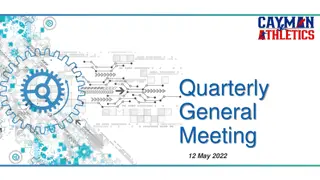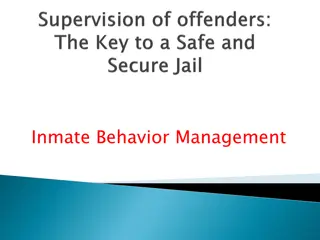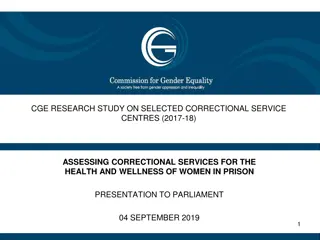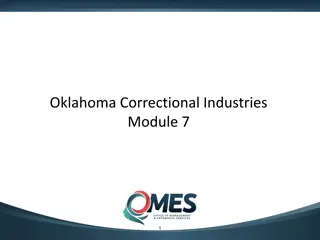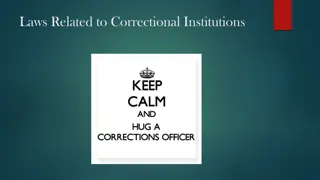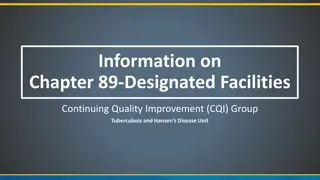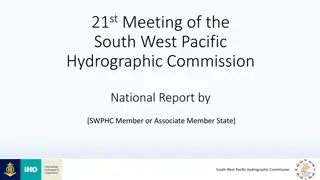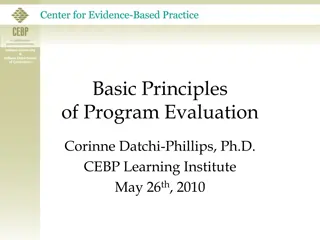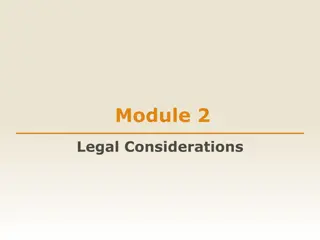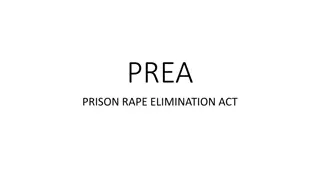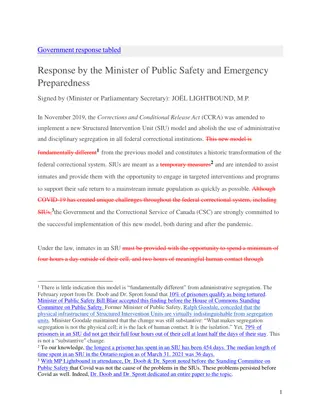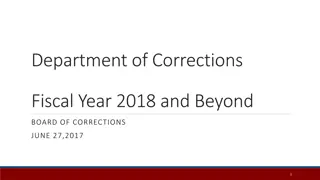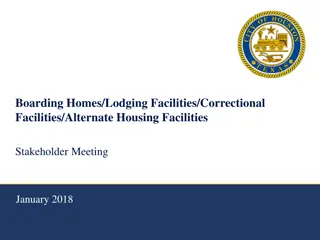Overview of Correctional Funding Commission Report
This document provides an overview of the report prepared by the Special Commission on Correctional Funding. Motivations for the review include controlling correctional costs and evaluating inmate programming to improve the corrections system. The report covers details on commission proceedings, staffing analysis, spending matrices, historical data, and capacity comparisons. It also discusses the role of the Legislature in correctional agency funding and jurisdiction. The document emphasizes the need for understanding operational and programmatic costs to enhance rehabilitative programming. Access to the full report and additional resources is available online.
Download Presentation

Please find below an Image/Link to download the presentation.
The content on the website is provided AS IS for your information and personal use only. It may not be sold, licensed, or shared on other websites without obtaining consent from the author.If you encounter any issues during the download, it is possible that the publisher has removed the file from their server.
You are allowed to download the files provided on this website for personal or commercial use, subject to the condition that they are used lawfully. All files are the property of their respective owners.
The content on the website is provided AS IS for your information and personal use only. It may not be sold, licensed, or shared on other websites without obtaining consent from the author.
E N D
Presentation Transcript
Report of the Report of the Special Commission on Correctional Commission on Correctional Funding Funding Special Prepared for Filing on January 31, 2022
Documents comprising this report This PowerPoint Presentation Appendices A. Charge of the Commission B. Members of the Commission C. Proceedings of the Commission D. Staffing and Cost Analysis Spreadsheet with Supplemental Computations Spreadsheet E. Summary Narratives of National Institute of Corrections Process 1. NIC Executive Summary 2. Essex County Staffing Analysis Executive Summary 3. Bristol County Staffing Analysis Executive Summary 4. Hampden County Staffing Analysis Executive Summary 5. DOC Staffing Analysis Executive Summary F. Sheriffs Comprehensive Spending Matrix (Programs) G. Department of Corrections (DOC) Comprehensive Spending Matrix (Programs) H. Fixed Asset Inventory I. Impacts of Chapter 69 Inventory (Narrative and Spreadsheet) J. Historical Correctional Populations Data K. Comparisons of Capacity Metrics All the above documents comprising the Commission report are available in electronic form at correctionalfunding.com. Additionally, that website includes recordings of Commission sessions, written public testimony and additional resources that were used in Commission discussion and analysis. 2
Overview of this document Motivations for Commission Review Controlling Correctional Costs Evaluating Inmate Programming Next steps 3
Overview of this document Motivations for Commission Review Controlling Correctional Costs Evaluating Inmate Programming Next Steps 4
Motivations for Commission Review Motivations for commission review The Legislature has defined by statute the Department of Corrections and the Commonwealth s Sheriff Offices, and it retains the ultimate responsibility for correctional agency funding, powers and jurisdiction. It must develop a better understanding of operational, programmatic and attendant costs to make the corrections system the best it can be. Over the past decade, many correctional facilities have experienced declining correctional populations. This reduction in population has not led to declining correctional spending. Per inmate costs vary widely across counties. Many outside the correctional system have concern that inmates are not receiving the rehabilitative programming that they need. These motivations are implicit in the charge to the Commission and were also expressed in public testimony to the Commission. 5
Motivations for Commission Review The Legislature has defined the Department of Corrections and the Office of Sheriff The Department of Corrections (DOC) and each of the Commonwealth s fourteen Sheriff s Offices are defined and regulated by statute, and the Legislature has ultimate authority through the general laws over the structure, function and funding of these offices. Specifically, the Legislature is responsible for: Budget make revenue decisions including both direct appropriations and spending practices. Powers and Jurisdiction determine the structure, organization, coverage area, and authority of each Sheriff s Office and the DOC. Oversight exclusive authority to exercise oversight, hold public hearings, receive timely reports and documents, and enact reforms. 6
Motivations for Commission Review To deliver a modern corrections system, the Legislature must have clear insight into its operations The Legislature, stakeholders, other governmental units and the general public deserve clear corrections data, reported uniformly and regularly. The Legislature must develop better understandings of the staffing, programming, and other attendant costs of operating the Commonwealth s correctional and detention facilities. The current disparities in data reporting in a number of areas make budgetary assessments and comparisons difficult, at best. If the Legislature is going to adequately fund the corrections system, it must be able to understand the actual costs of operations and programming at each facility, including costs generated by legislative mandates. 7
Motivations for Commission Review Total Year End Full Time Employees vs. Population Over the past decade, declining correctional populations have not led to declining correctional staffing 30000 25000 20000 15000 10000 5000 0 2010 2011 2012 2013 2014 2015 2016 2017 2018 2019 DOC FT Employees County FT Employees DOC Pop County Pop Population declines do not necessarily indicate that staffing should decline. See further discussion on slides 21-28. For Employee Count, see Appendix D. For Population, see Appendix J. 2020 is omitted as a possible outlier as to population, but shows a further considerable population drop. Note that DOC and the County facilities are entirely separate entities. They are presented together on this slide to give a comprehensive picture. 8
Motivations for Commission Review County & DOC Average Daily Population vs Design Capacity 16000 14000 2015 county capacity increase due to reevaluation Design/rated capacity of facilities at the county level now substantially exceeds population. 12000 Population and Design Capacity 10000 Total County Design Capacity 8000 DOC Design Capacity Total County Average Daily Population 6000 DOC Average Daily Population 4000 2000 0 1989 1991 1993 1995 1997 1999 2001 2003 2005 2007 2009 2011 2013 2015 2017 2019 Year Source: Compilation of Quarterly Reports on the Status of Prison Capacity, including historical previous reports in series from state library (under title Quarterly Reports on Status of Prison Overcrowding). Data reported is from the first quarter report in each year, which includes average for previous calendar year. See Table 2 for DOC facilities and Table 5 for County facilities. 9
Motivations for Commission Review Direct Appropriation plus non-MMARS* spending per Average Daily Supervisory Population** $120,000 $100,000 DOC $80,000 $60,000 Per inmate costs vary widely across counties. $40,000 $20,000 $0 All Other Health Programming (MMARS only) NonMMARS (some programming) * MMARS is the Massachusetts Management Accounting and Reporting System which the Comptroller has established pursuant to Section 7 of Chapter 7A of the General Laws. Certain small accounts in sheriff operations are not within the MMARS system. These are referred to as non-MMARS spending in this report. **It has been suggested that an alternative calculation to determine the cost per inmate would be to use the total number of bookings each year against the total budget. However, the commission did not deliberate as to the appropriateness of this metric. See Appendix D for sources. We omit Dukes and Nantucket from per inmate comparative cost analysis because they are so small that their per inmate numbers vary widely by year. FY2019 is used as the comparison year as it is the most recent pre-COVID year. Average Daily Supervisory Population (ADSP) is the fiscal year average. As noted in the CFO vetted spreadsheet: Direct Appropriation includes all of the agency's personnel and facility expenses, including regional services, such as Lockup, E911 Center, Community Outreach Programs, most of which have no relation to the inmate population. Therefore, this ratio may be misleading. For DOC this slide, shows total operational spending. For the Counties, Direct Appropriation includes 95% or more of all spending (including non-MMARS as agency reported) except in the following three counties where Direct Appropriation is less than 95% of total spending: Essex (92%), Barnstable (87%), Berkshire (87%). The top slice in the bars is non-MMARS spending, mostly applied to programming. MMARS is the state s general ledger system. Note that slide excludes Capital, Trust and Federal grant spending all minor categories. 10
Motivations for Commission Review Full Time Equivalent Employees (FTE) per Average Daily Supervisory Population (ADSP) 1.20 1.00 Variations also appear in per inmate staffing, with a similar ranking. 0.80 0.60 DOC 0.40 0.20 0.00 FTE/ADSP Note: Full Time Equivalent staffing is as of the first January pay period in the fiscal year (2019) for the counties. For DOC, it is the average through the fiscal year (2019). See Appendix D. * Some of these differences could be explained by differences in use of contract vendors the commission lacks the data to compare the extent to which vendor contracts affect FTEs. Counties marked with an asterisk have outsourced health care contracts where spending exceeds 10% of direct appropriations ranging up to 18% in Bristol County. See Appendix D. 11
Motivations for Commission Review FTE/ADSP as function of ADSP* 1.20 1.00 BERKSHIRE Economies of scale explain some of the variation: larger facilities have lower staff per inmate. BARNSTABLE Staff to Inmate Ratio (FTE/ADSP) FRANKLIN 0.80 MIDDLESEX HAMPSHIRE NORFOLK SUFFOLK HAMPDEN 0.60 WORCESTER PLYMOUTH BRISTOL DOC: 0.40 ESSEX 0.20 0.00 0 200 400 600 800 1,000 1,200 1,400 1,600 Average Daily Supervised Population See Appendix D. FTE = Full Time Equivalent Employee; ADSP = Average Daily Supervisory Population. Note: If Dukes County were included on this slide, it would have an FTE/ADSP ratio of 1.9. In 2020, it had an FTE/ADSP ratio of 4.4. 12
Motivations for Commission Review Average salary per FTE adjusted by regional wage levels by county 100,000 DOC: 90,000 80,000 Even with wage normalization salaries do vary across counties, but some variation may be due to professional mix. 70,000 60,000 50,000 40,000 30,000 20,000 10,000 - Salary/FTE adjusted by labor market average wage for Protective Services Workers in May 2019 Source for labor market average wage level for Protective Services: Bureau of Labor Statistics, https://www.bls.gov/oes/2019/may/ma_counties.htm. For DOC, since it is a statewide agency, no regional adjustment was applied. See Appendix D. 13
Motivations for Commission Review Direct Appropriation/ADSP vs. Predicted Direct Appropriation/ADSP $120,000 $100,000 Scale and salary level can be used to build a linear model* that explains much of the variation in appropriation per ADSP, but . . . $80,000 $60,000 $40,000 $20,000 $0 Actual Predicted based on linear regression against salary and scale variables * Basis of prediction: Linear regression of Direct Appropriation/ADSP against Salary/FTE and ADSP. Salary/FTE and ADSP are both significant at p < .01. Program spending/ADSP (normalized by salary factor and including non-MMARS/ADSP) is not a significant predictor of overall spending when the other two variables (Salary/FTE and ADSP) are included in a three variable regression. This linear model closely resembles the model developed in the 2015 PCG Study of Sheriff Spending, which uses scale to determine staffing needs and then adjusts for county level personnel costs. See https://correctionalfunding.com/wp-content/uploads/2019/12/PCG-Study-on-Sheriffs-Funding-Formula.pdf. The commission charge calls for a funding formula for each sheriff s office as further discussed below, the commission concludes that no formulaic approach can reliably predict funding needs, but we did experiment with the model in this slide and others. 14
Motivations for Commission Review Direct Appropriation/ADSP vs. Predicted Direct Appropriation/ADSP Residual as % of Predicted 20.0% . . . the unexplained residual differences are still large see discussion in next section on factors influencing staffing needs. 15.0% 10.0% 5.0% 0.0% -5.0% -10.0% -15.0% -20.0% -25.0% % Deviation Basis of prediction: Linear regression of Direct Appropriation/ADSP against Salary/FTE and ADSP. Salary/FTE and ADSP are both significant at p < .01. Program spending/ADSP (normalized by salary factor and including non-MMARS/ADSP) is not a significant predictor of overall spending when the other two variables (Salary/FTE and ADSP) are included in a three-variable regression. 15
Motivations for Commission Review Salary Normalized Care and Custody Spending per ADSP $90,000 $80,000 Correcting for salary-level variations and accepting sheriff s care & custody classification of spending reduces but does not eliminate variation see discussion in next section on factors influencing staffing needs. $70,000 $60,000 $50,000 $40,000 $30,000 $20,000 $10,000 $0 Care and Custody Spending per ADSP Normalized by Salary Factor Note: Care & Custody Operational Spending is as previously reported to the House Ways and Means Committee and may not reflect a consistent classification methodology. Salary normalization adjust spending amounts by the differences in average salary level across counties. See Appendix D. 16
Motivations for Commission Review Motivations for commission review - summary The Legislature has defined by statute the Department of Corrections and the Commonwealth s Sheriff Offices, and it retains the ultimate responsibility for correctional agency funding, powers and jurisdiction. It must develop a better understanding of operational, programmatic and attendant costs to make the corrections system the best it can be. Over the past decade, many correctional facilities have experienced declining correctional populations. This reduction in population has not led to declining correctional spending. Per inmate costs vary widely across counties as shown above, several simple formulaic models for understanding the variation do not explain the variation; we will explore the challenges to formulaic models for staffing in the next section. Many outside the correctional system have concern that inmates are not receiving the rehabilitative programming that they need the commission was not able to quantify programming adequacy, see further discussion in section on Evaluating Inmate Programming. 17
Overview of this document Motivations for Commission Review Controlling Correctional Costs Challenges in Evaluating Inmate Programming Next Steps 18
Controlling Correctional Costs As for many organizations, payroll is the largest component of correctional spending Total State and County Correctional Spending 2016-2020 (excluding capital) DOC Payroll DOC all other HOC all other HOC Payroll Source: See Appendix D. 19
Controlling Correctional Costs Nationally, low inmate-to-staff ratios correlate with low incarceration rates. Hard to interpret. Inmate-to-staff ratio in local jails (including HOC in MA) vs. state-local incarceration rate (2019) Alternative interpretations include: In low incarceration states like MA, those incarcerated may be higher risk offenders than in high incarceration states in MA lower risk offenders, who would need less correctional officer supervision, may be less likely to be incarcerated (more likely to be supervised in the community or not under supervision). Lower incarceration states have lower crime rates and incarcerated offenders in these states are not different from those in other states, leaving the correlation noted in this table unexplained. Increased focus in Massachusetts on internal and reentry programming raises overall costs and staffing needs both for programming per se and for custodial support for programming. Increased focus on programming in Massachusetts drives down incarceration rates. Older facilities in Massachusetts may require more staffing due to layout or lack of automation. 8 Jail inmate to staff ratio from Census of Jails 7 WV CA KY LA TN AL 6 IN UT MS GA 5 NV AR ID OK SC MO WI AZ WA OR OH VA WY TX 4 NC CO NM FL KS MT SD PA 3 IO NB ND ME MN IL NH NJ MD MI 2 DC MA NY 1 AK 0 0 200 Total Incarcerated Population (all levels) per 100000 people 400 600 800 1000 1200 Sources: Correctional Populations in the United States, 2019, Appendix Table 1. https://bjs.ojp.gov/sites/g/files/xyckuh236/files/media/document/cpus19st.pdf, Census of Jails, 2005-2019, Table 18, https://bjs.ojp.gov/sites/g/files/xyckuh236/files/media/document/cj0519st.pdf . Compare previous discussion of national ratios in PCG Human Services study on Sheriff Funding Formula. Available online at: https://correctionalfunding.com/wp-content/uploads/2019/12/PCG-Study-on-Sheriffs-Funding-Formula.pdf 20
Controlling Correctional Costs Population declines do not necessarily indicate that staffing should decline Staffing ratios at peak population cannot be taken as a normative baseline current staffing ratios may be more appropriate. Population declines do not necessarily reduce the necessary number of needed housing units many units serve unique functions within a facility. More programming and specialized programming requires higher custodial staffing to supervise movement as well as staffing to conduct the programming. Increased out-of-cell time, medically assisted treatment, and other changes mandated by criminal justice reform generate increased staffing needs (although some believe costs could be reduced if the populations in restrictive settings could be reduced). With more diversion and shorter sentences as a result of criminal justice reform, the remaining sentenced population may have higher supervision needs. 21
Controlling Correctional Costs Recent DOC staffing levels are consistent with historical DOC staffing levels when at similar population sizes DOC Population Average 2019, 2020 Year End 2021 13000 1990 Mid 1987 11000 9000 Population 8000 8000 6000 6000 7000 5000 Staffing 4600 (actual avg.) 5406 (authorized) 4539 (actual) 4482 (authorized) 1989 1992 1995 1998 2001 2004 2007 2010 2013 2016 2019 DOC ADP DOC s population in 2019 and 2020 was around 8000. Average FTE staffing for the department in those years was around 4600. See Appendix D. DOC last had a population as low as 8000 in 1990. See Appendix J. The fiscal 1991 state budget (passed in mid-1990) authorized 4700 positions for administration and operation of DOC facilities, plus another 150 for administration of the department and another 556 for health and other programming, for a total of 5406 positions. See Chapter 150 of the Acts of 1990. As of year-end 2021, the DOC custodial population was 5,999. DOC had 4539 Full Time employees as of December 4, 2021 (from CThru) DOC last had a population of 6000 in mid-1987. The fiscal 1988 budget passed in mid-1987 authorized 3731 positions for administration and operation of DOC facilities, plus another 236 for administration of the department and another 515 for health and other programming, for a total of a total of 4482 positions for the Department of Corrections See Chapter 199 of the Acts of 1987. These comparisons are imprecise because the mix of contracted services may not be the same. Additionally, we are comparing authorized positions to actual positions. Historical DOC population trends compiled from DOC reports at https://willbrownsberger.com/50-years-of-crime-and-punishment-in-massachusetts- 1965-2015/. December DOC data from weekly count sheets and CThru. 22
Controlling Correctional Costs Custodial staffing needs depend on much more than a ratio to inmates Facility characteristics drive correctional staffing -- Fragmented housing units with poor sight-lines require more officers to provide needed supervision. Manual or relay-switch door controls require more operator involvement than modern touch panels as officers and inmates pass through locked doors. Layout affects the volume of movement needed for program participation some facilities have the capacity for programming within housing pods. To the extent inmate programming occurs out-of-cell and out-of-housing-unit, officers are needed to escort inmates or supervise their independent movement from cell to program venue. New technology like video conferencing and programming on tablets may reduce staffing needs. Inmate characteristics drive correctional staffing -- People in conflict need separation, multiplying the number of separately supervised housing units. Vulnerable people need separation from predators, multiplying the number of separately supervised housing units. Inmates with infectious disease need separation from other inmates and COVID precautions have encouraged more single room bunking and lower dormitory occupancy, spreading inmates across more housing units. Inmates with negative behavior patterns may require more supervision; some believe that officers who lack de-escalation skills may need more backup and that facilities lacking clear incentive structures for better inmate behavior may sustain more poor behavior. Inmates with mental health and substance needs require more supervision; some believe poor mental health treatment may increase the supervision needs for some inmates. Inmate needs or preferences for single bunking may increase the number of cells needed. Bargained staffing rules may also affect staffing needs. Legislative policy changes, including specific program mandates and housing rules may increase staffing needs. 23
Controlling Correctional Costs Setting the appropriate staff level for a facility requires a bottom-up analysis of needed posts Define the set of housing units that will be operated For each housing unit, assess the number of officers needed on the unit to provide adequate supervision at different times of day Sightlines of the facility Inmate and officer safety given conflict levels Volume of inmate movement; needs for escorts during movement Assess the number of officers needed to provide external supervision, post relief and emergency response to a cluster of housing units Identify other posts that need coverage perimeter security, door control, visit supervision, transportation, intake searches Consider strategies to reduce supervision needs due to movement spread movement throughout the day to reduce peak needs Calculate shift relief factors staffing depth should allow for absences due to vacation, illness, injury, training, etc. 24
Controlling Correctional Costs The National Institute of Corrections (NIC) conducted a prototype staffing analyses To assist the Commission in understanding the complexities of a staffing analysis, the National Institute of Corrections (a subsidiary of the Department of Justice and a nonregulatory agency), provided training and guidance to the 4 Pilot Site Agencies chosen by the Commission. Facilities in Essex, Bristol, and Hampden Counties, and one Department of Correction Facility (Gardner) engaged in the analysis. The NIC staffing process is collaborative, involving facility staff and supervisors in a team review of each needed post within the facility. The basic output of the process is an inventory of all the posts that need to be covered in the facility, together with a shift relief factor for each type of post (24/7 vs. 9-5; essential vs. non-essential) The results of the process depend to some extent on the personnel involved, but in every case, the review teams felt that they had developed important operational insights. 25
Controlling Correctional Costs The Commission finds that there is no formula driven alternative to management budgeting The NIC discussion and process convinced the commission that staffing ratios cannot capture the many factors that may drive staffing needs differently across facilities. Commissioners felt that the NIC approach should be implemented more broadly to better understand staffing needs. The NIC approach does heavily depend on the judgment of the team involved and may be more useful as a management tool than as a legislative-level budgeting instrument. In the best case, it would take several years, strong management support in every correctional facility, and sustained collaboration across facilities for the NIC approach to become robust enough to form the basis of state-wide budgeting. Of note, NIC is working with the Pilot Sites to complete their staffing studies (Phase II) and NIC will be conducting training with each of the remaining Sheriff s Offices so they can in turn conduct their own staffing analysis (Phase III). 26
Controlling Correctional Costs Nonetheless, low occupancy suggests opportunities for cost savings Total County Design Capacity, Bed Count, Historical Maximum Population & 2021 Population Average Daily Population as % of Design/Rated Capacity 2021, Q3 Barnstable 57% 16000 47% Bristol 115% 14000 63% 12000 Essex 66% 10000 98% Hampden 51% 8000 43% 6000 Middlesex 42% 54% 4000 Plymouth 55% 2000 47% Worcester 0 78% Note that 2021 Population reflects COVID releases. Counties Total 58% DOC Custody 83% Design/Rated Capacity Bed Count 0% 20% 40% 60% 80% 100% 120% 140% Maximum Historical ADP Dec 6, 2021 Population % Occupied Source: Compilation of Quarterly Reports on the Status of Prison Capacity, including historical previous reports in series from state library (under title Quarterly Reports on Status of Prison Overcrowding). Data reported is from the first quarter report in each year, which includes average for previous calendar year. See Table 2 for DOC facilities and Table 5 for County facilities. Bed Count and December 6, 2021 populations calculated from a survey to each Sheriff office recording bed count and inmate population on December 6, 2021. See Appendix J 27
Controlling Correctional Costs Interim recommendation: Improve reporting to better evaluate possibilities for consolidation or alternative housing models, including mental health facilities Streamline and improve existing capacity and population reports Define capacity uniformly Improve transparency as to inmate density and use of space provide regular counts of beds by cell (or dormitory), housing unit, and facility An idea that had special currency with the commissioners was to expand specialized units across counties and DOC 18 to 24 year olds, mental health, women, special management, protective custody and seek opportunities for consolidation; additionally, perhaps to explore expansion of step down from DOC to HOC. 28
Overview of this document Motivations for Commission Review Controlling Correctional Costs Evaluating Inmate Programming Next Steps 29
Evaluating Inmate Programming The Commission found that DOC and all Sheriffs take inmate programming seriously Programming is the centerpiece in sheriffs presentations about their facilities. Attitudes have evolved dramatically over the last decade. The obligation to release inmates in better condition than they were in when they arrived is universally accepted. Quality programs feature evidence-based models. Reentry planning must occur starting as early as possible and be reinforced by program participation. All Commissioners agreed on the need for additional programming resources. 30
Evaluating Inmate Programming As to inmate programming, the Commission was charged to: Analyze spending on mental health and substance use disorder services and the appropriate levels of funding necessary to meet the service needs of incarcerated people; Review all discretionary programming offered in state prisons and houses of correction and analyze geographical disparities in discretionary programming. 31
Evaluating Inmate Programming The Commission concluded it could not evaluate appropriate levels of program spending Different clinical philosophies can lead to different clinical recommendations, even when discussing one single person in need. Even if the commission could agree on a set of evidence-based program prescriptions for defined clinical needs, we lack accurate and consistent clinical data as to needs (see next two slides). Even for defined programs, per inmate program costs vary widely depending on usage and overhead allocation so even if we knew the right program mix, cost would be hard to estimate. True estimates of a program s costs in an incarcerated setting should include the hard-to-measure impact of program participation on care and custody spending (more spending because of more inmate movement, but also perhaps less spending because of improved behavior). Some valuable programs are group-led and/or volunteer-led and their cost consists entirely of care and custody costs for movement. 32
Evaluating Inmate Programming The need for more uniform definitions Much of the Commission s work centered on trying to reconcile vastly different reporting methods by and between corrections agencies. The commission found that much of the available data was inconsistent; the DOC and the fourteen Sheriffs Offices agree on the need to produce uniform data and financial reporting on topics including programming, mental health spending, employee time allocations, among others. There is little to no uniformity of definitions for even basic terms such as evidence based , recidivism * or substance use disorder. These inconsistencies make a complicated system opaque and stubbornly resistant to substantive analysis. * Note: The Sheriffs and DOC are actively working with EOPSS and EOTSS to standardize the definition of recidivism as part of the Commonwealth s Offender Management System (OMS) Upgrade and the Standardizing and Operationalizing Criminal Justice Data Initiative. 33
Evaluating Inmate Programming Raw reported rates of substance use, whether by self-report or facility diagnosis, vary unrealistically widely across facilities no adequate basis for assessing needs. Percentage Substance Use Self-Report & Facility Diagnosis 100% Substance Use Self-Report 90% Substance Use Facility Diagnosis 80% 70% 60% 50% 40% 30% 20% 10% 0% Barnstable Berkshire Bristol Dukes Essex Franklin Hampden HampshireMiddlesex Norfolk Plymouth Suffolk Worcester Note: Self Report (inmate s own assessment) & Facility Diagnosis from Sheriffs Comprehensive Spending Matrix, Appendix F. No data available from DOC. Missing bars in the chart reflect missing data. Nantucket excluded because all in-custody operations occur at Barnstable. Suffolk contracted with a new comprehensive medical and mental health vendor beginning March 1, 2021 and some of the data requested is unavailable. 34
Evaluating Inmate Programming Raw reported rates of serious mental illness, based on self- report, vary unrealistically widely across facilities no adequate basis for assessing needs Percentage Serious Mental Illness Self-Report and Facility Diagnosis 100% Serious Mental Illness Self-Report 90% Serious Mental Illness Facility Diagnosis 80% 70% 60% 50% 40% 30% 20% 10% 0% Barnstable Berkshire Bristol Dukes Essex Franklin Hampden Hampshire Middlesex Norfolk Plymouth Suffolk Worcester Note: Self Report (inmate s own assessment) & Facility Diagnosis from Sheriffs Comprehensive Spending Matrix, Appendix F. No data available from DOC. Missing bars in the chart reflect missing data. Nantucket excluded because all in-custody operations occur at Barnstable. Suffolk contracted with a new comprehensive medical and mental health vendor beginning March 1, 2021 and some of the data requested is unavailable. 35
Evaluating Inmate Programming Correctional facilities prepared a rich and comprehensive inventory of all types of programming across facilities for the commission, but . . . Data was not available for several program metrics; There were inconsistencies in the method of reporting data; Similar programs were categorized differently at each facility; Differences in reporting hampered comparisons between offices; Through continued collaboration, the inventory will continue to improve. 36
Evaluating Inmate Programming Program attendance and cost are reported for roughly half of all programs Percentage of Data Provided Across All Facilities 100% 90% 80% 70% 60% 52% 49% 50% 45% 40% 30% 20% 10% 0% # Served Annually Annual Time Cost Operational Cost Note: See appendix F & G, # Served Annually is a count all programs with any numerical values for annual participation, including estimates. Does not count data reported in non-numerical values or blank cells, does count "0" values. 37
Evaluating Inmate Programming Program Categorization Data Limitations Similar programs in different facilities were categorized by type differently, especially among mental health/substance use programs and support/mentorship group programs Each correctional facility broke down programs differently, some more granular than others, making program counts misleading Program Purpose (number 1-7) was also determined differently at each facility, with notable differences in categorization of programs that are statutorily required 38
Evaluating Inmate Programming Reported program purpose classifications were not uniform For example, compare Dukes County with 138 statutorily required programs to Essex, Barnstable or Plymouth 7 = Law Enforcement function otherwise absent 6 = Community support otherwise absent 1 = Statutorily required 2 = Criminogenic Risk Reduction 3 = SU &/or MH 4 = Climate 5 = Victim services Total Programs Count % Count % Count % Count % Count % Count % Count % Barnstable Berkshire Bristol Dukes Essex Franklin Hampden Hampshire Middlesex Nantucket Norfolk Plymouth Suffolk Worcester DOC 0 0% 14% 19% 61% 2% 10% 24% 16% 7% 0% 15% 4% 21% 8% 4% 19 51 49 95 100 33 134 83 53 0 60 6 97 17 63 54% 65% 66% 42% 89% 80% 74% 86% 72% 0% 92% 25% 92% 45% 34% 13 27 27 25 64 24 68 53 23 0 17 10 41 5 34 37% 34% 36% 11% 57% 59% 38% 55% 31% 0% 26% 42% 39% 13% 18% 1 3% 33% 0% 9% 70% 59% 73% 17% 32% 0% 82% 63% 90% 0% 79% 3 5 0 9% 6% 0% 6% 11% 2% 7% 17% 18% 0% 9% 42% 0% 0% 1% 17 45 18 35 6 32 39 44 46 17 64 0 2 13 119 49% 57% 24% 15% 5% 78% 22% 46% 62% 100% 98% 0% 2% 34% 63% 10 4 9 7 9 3 10 7 11 0 3 0 7 0 0 29% 5% 12% 3% 8% 7% 6% 7% 15% 0% 5% 0% 7% 0% 0% 35 79 74 226 112 41 180 96 74 17 65 24 106 38 188 11 14 138 2 4 43 15 5 0 10 1 22 3 8 26 0 21 78 24 132 16 24 0 53 15 95 0 148 14 12 1 12 16 13 0 6 10 0 0 1 Alll Facilities 276 20% 860 63% 431 32% 633 47% 93 7% 497 37% 80 6% 1355 Range 138 128 63 148 16 119 11 209 Note: Count is defined as the number of programs at this facility categorized with this number. % column is the percent of total programs at this facility categorized with this number (Count/total programs) Programs may be categorized with more than one number and the sum of each row will exceed 100% of the Total Programs column. Orange cells highlight the highest and lowest values of each program category, excluding Nantucket. See appendix F & G 39
Evaluating Inmate Programming Based on data the Commission collected, we were able to compare overall program spending levels 2019 Direct Program Spending per Inmate (excludes related custody costs) $8,000 $7,227 $7,000 $6,585 $6,060 $6,000 $5,186 $5,108 $4,901 $4,849 $4,819 $5,000 $4,209 $4,127 $4,000 $3,048 $3,000 $2,000 $1,097 $1,000 $0 BARNSTABLE BERKSHIRE MIDDLESEX FRANKLIN NORFOLK SUFFOLK HAMPSHIRE HAMPDEN PLYMOUTH WORCESTER ESSEX BRISTOL Program spending (including non MMARS) per Average Daily Supervised Population Note: These comparisons derive from analysis of MMARS general ledger spending data combined with any off- MMARS spending. As noted in the CFO vetted spreadsheet: For many agencies, expenditures from accounts not covered in MMARS are spent entirely on program services. However, . . . , this is not the case for all agencies. In this slide, all non-MMARS spending is treated as program spending. See Appendix D. Note that counties are arranged in descending order of total spending per inmate. 40
Evaluating Inmate Programming Direct appropriation (less program services in MMARS) as function of program spending including non-MMARS (both salary normalized and per ADSP) $100,000 Non-program spending -- direct appropriation per ADSP (excluding programming) FRANKLIN BERKSHIRE $90,000 BARNSTABLE Higher program spending correlates with higher non- program spending. $80,000 NORFOLK MIDDLESEX HAMPSHIRE DOC: $70,000 SUFFOLK WORCESTER PLYMOUTH HAMPDEN $60,000 BRISTOL $50,000 ESSEX $40,000 $30,000 $20,000 $10,000 $0 $0 $1,000 $2,000 $3,000 $4,000 $5,000 $6,000 $7,000 $8,000 $9,000 Program spending per ADSP, Salary Normalized, including non-MMARS spending Note: These comparisons derive from analysis of MMARS general ledger spending data combined with any off- MMARS spending. As noted in the CFO vetted spreadsheet: For many agencies, expenditures from accounts not covered in MMARS are spent entirely on program services. However, . . . , this is not the case for all agencies. In this slide, all non-MMARS spending is treated as program spending. See Appendix C 41
Evaluating Inmate Programming The Commission recommends improvement of uniformity, accountability, and transparency for inmate programming The Commission does not recommend merely increasing reporting requirements within the existing structure the commission experience shows that facility practices vary too widely to generate useful cross- facility reporting about inmate programs. The Commission recommends a new structure to: Develop standardized definitions and enhanced reporting Define criminogenic risks and needs Standardize a portfolio of responsive programs to meet inmate needs and reduce recidivism Standardize risk-need intake instruments and ongoing clinical assessments Monitor program implementation for quality and fidelity to program design Monitor inmate program access and participation across all housing arrangements, including restrictive housing, mental health watch and other forms of specialized housing Support inmate cognitive-behavioral development and reentry planning Report publicly on results of monitoring and recommend changes as needed Where appropriate assure connection to services provided under the MassHealth 1115 Demonstration Waiver Provide comprehensive perspective on needs and responsiveness to needs across all facilities Note: We are using the word program to mean any form of programming, intervention, or service designed to address risks or needs including individual clinical interventions. 42
Evaluating Inmate Programming Options for improvement of programming, reporting on programming, and accountability -- commissioners had divergent views: Office within Department of Correction Office within Health and Human Services Independent agency Initiative on the part of Massachusetts Sheriffs Association (in collaboration with DOC) possibly with its own line item Academic center of excellence that oversees reporting and capacity building Line item in each agency s budget for programming and related reporting 43
Overview of this document Motivations for Commission Review Controlling Correctional Costs Evaluating Inmate Programming Next Steps 44
Next Steps The Legislature should work with the Sheriffs, DOC, and concerned advocates to . . . Streamline and improve existing reporting of capacity and population to better evaluate possibilities for consolidation or alternative housing models, including mental health facilities (very short term): Streamline existing capacity and population reports Define capacity uniformly Improve transparency as to inmate density and use of space provide regular counts of beds by cell or dormitory, housing unit and facility Implement a new structure (medium-term) to: Develop standardized definitions and enhanced reporting Define criminogenic risks and needs Standardize a portfolio of responsive programs to meet inmate needs and reduce recidivism Standardize risk-need intake instruments and ongoing clinical assessments Monitor program implementation for quality and fidelity to program design Monitor inmate program access and participation across all housing arrangements, including restrictive housing, mental health watch and other forms of specialized housing Support inmate cognitive-behavioral development and reentry planning Report publicly on results of monitoring and recommend changes as needed Where appropriate assure connection to services provided under the MassHealth 1115 Demonstration Waiver Provide comprehensive perspective on needs and responsiveness to needs across all facilities 45
Next Steps The Legislature should also work with the Sheriffs, DOC, and concerned advocates to build uniformity in all correctional reporting: Review and streamline all currently existing reporting requirements imposed on DOC and Sheriffs; Identify methods of establishing shared and common definitions for critical operational and programming terms; Establish uniform and comprehensive reporting requirements at regular intervals; and Require a regular and recurring audit and review of DOC and Sheriff reports for consistency and accuracy. 46
